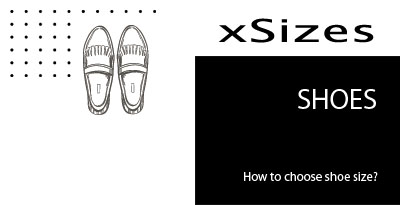Shoe size conversion charts US, UK, EU

Understanding Shoe Size Variations: US, UK, and EU Systems
Shoe sizes can vary depending on the measurement system used in different regions. The most common shoe size systems are the US, UK, and EU. Understanding these variations is crucial when shopping for shoes internationally or when converting sizes between different systems. Each system has its own unique sizing conventions, and being familiar with them will help you find the right fit.
Shoe size guide
In this article you will find such sizes as:- Understanding Shoe Size Variations: US, UK, and EU Systems
- Importance of Shoe Size Conversion: Buying the Right Fit
- Shoe Size Conversion: US to UK
- Shoe Size Conversion: UK to US
- Shoe Size Conversion: US to EU
- Shoe Size Conversion: UK to EU
- Factors to Consider in Shoe Size Conversion
- Tips for Accurate Shoe Size Measurement
- Common Mistakes to Avoid in Shoe Size Conversion
- Using Shoe Size Conversion Charts Effectively
- Online Tools and Resources for Shoe Size Conversion
- FAQ
Importance of Shoe Size Conversion: Buying the Right Fit
Accurate shoe size conversion is essential to ensure a proper fit and avoid discomfort or potential foot problems. Wearing shoes that are too tight or too loose can lead to blisters, foot pain, or even injuries. By converting shoe sizes correctly, you can make informed decisions when purchasing shoes from different regions or using size charts.
Shoe Size Conversion: US to UK
Converting shoe sizes from US to UK can be done by adding or subtracting a specific number. In general, to convert from US to UK, you need to subtract two sizes. For example, if you wear a US size 9, you would typically need a UK size 7. However, it's important to note that this conversion may vary between brands, so it's always recommended to consult a size conversion chart provided by the specific brand.
Women's Shoe Sizes
| US | UK | Europe |
|---|---|---|
| 4 | 2 | 35 |
| 4.5 | 2.5 | 35 |
| 5 | 3 | 36 |
| 5.5 | 3.5 | 36 |
| 6 | 4 | 37 |
| 6.5 | 4.5 | 37 |
| 7 | 5 | 38 |
| 7.5 | 5.5 | 38 |
| 8 | 6 | 39 |
| 8.5 | 6.5 | 39 |
| 9 | 7 | 40 |
| 9.5 | 7.5 | 40 |
| 10 | 8 | 41 |
| 10.5 | 8.5 | 41 |
| 11 | 9 | 42 |
| 11.5 | 9.5 | 42 |
| 12 | 10 | 43 |
| 12.5 | 10.5 | 43 |
| 13 | 11 | 45 |
| 13.5 | 11.5 | 45.5 |
| 14 | 12 | 46 |
| 15 | 13 | 47 |
Men's Shoe Sizes
| US | UK | Europe |
|---|---|---|
| 6 | 5 | 40 |
| 6.5 | 5.5 | 40 |
| 7 | 6 | 41 |
| 7.5 | 6.5 | 41 |
| 8 | 7 | 42 |
| 8.5 | 7.5 | 42 |
| 9 | 8 | 43 |
| 9.5 | 8.5 | 43 |
| 10 | 9 | 44 |
| 10.5 | 9.5 | 44 |
| 11 | 10 | 45 |
| 11.5 | 10.5 | 45 |
| 12 | 11 | 46 |
| 13 | 12 | 47 |
| 14 | 13 | 48 |
| 15 | 14 | 49 |
| 16 | 15 | 50 |
Shoe Size Conversion: UK to US
To convert shoe sizes from UK to US, you usually need to add two sizes. For instance, if you wear a UK size 7, you would typically need a US size 9. Keep in mind that shoe size conversion can vary slightly between brands, so it's best to refer to a size conversion chart provided by the brand you're purchasing from.
| UK | US Women's | US Men's |
|---|---|---|
| UK 0 | 2 | 0.5 |
| UK 0.5 | 2.5 | 1 |
| UK 1 | 3 | 1.5 |
| UK 1.5 | 3.5 | 2 |
| UK 2 | 4 | 2.5 |
| UK 2.5 | 4.5 | 3 |
| UK 3 | 5 | 3.5 |
| UK 3.5 | 5.5 | 4 |
| UK 4 | 6 | 4.5 |
| UK 4.5 | 6.5 | 5 |
| UK 5 | 7 | 5.5 |
| UK 5.5 | 7.5 | 6 |
| UK 6 | 8 | 6.5 |
| UK 6.5 | 8.5 | 7 |
| UK 7 | 9 | 7.5 |
| UK 7.5 | 9.5 | 8 |
| UK 8 | 10 | 8.5 |
| UK 8.5 | 10.5 | 9 |
| UK 9 | 11 | 9.5 |
| UK 9.5 | 11.5 | 10 |
| UK 10 | 12 | 10.5 |
| UK 10.5 | 12.5 | 11 |
| UK 11 | 13 | 11.5 |
| UK 11.5 | 13.5 | 12 |
| UK 12 | 14 | 12.5 |
| UK 12.5 | 14.5 | 13 |
| UK 13 | 15 | 13.5 |
| UK 13.5 | 15.5 | 14 |
| UK 14 | 16 | 14.5 |
| UK 14.5 | 16.5 | 15 |
| UK 15 | 17 | 15.5 |
Shoe Size Conversion: US to EU
Converting shoe sizes from US to EU involves a different approach. While there is no exact formula, a general guideline is to add 31 to your US shoe size to get the EU equivalent. For example, if you wear a US size 8, you would typically need an EU size 39. However, similar to other conversions, it's essential to consider brand-specific size charts for accurate conversions.
| US Men's | US Women's | EU Shoe Size |
|---|---|---|
| 0.5 | 2 | Size 32 EU |
| 1 | 2.5 | Size 32.5 EU |
| 1.5 | 3 | Size 33 EU |
| 2 | 3.5 | Size 33.5 EU |
| 2.5 | 4 | Size 34 EU |
| 3 | 4.5 | Size 34.5 EU |
| 3.5 | 5 | Size 35 EU |
| 4 | 5.5 | Size 35.5 EU |
| 4.5 | 6 | Size 36.5 EU |
| 5 | 6.5 | Size 37 EU |
| 5.5 | 7 | Size 37.5 EU |
| 6 | 7.5 | Size 38 EU |
| 6.5 | 8 | Size 39 EU |
| 7 | 8.5 | Size 39.5 EU |
| 7.5 | 9 | Size 40 EU |
| 8 | 9.5 | Size 40.5 EU |
| 8.5 | 10 | Size 41.5 EU |
| 9 | 10.5 | Size 41.5 EU |
| 9.5 | 11 | Size 42.5 EU |
| 10 | 11.5 | Size 43.5 EU |
| 10.5 | 12 | Size 44 EU |
| 11 | 12.5 | Size 44.5 EU |
| 11.5 | 13 | Size 45.5 EU |
| 12 | 13.5 | Size 46 EU |
| 12.5 | 14 | Size 46.5 EU |
| 13 | 14.5 | Size 47 EU |
| 13.5 | 15 | Size 47.5 EU |
| 14 | 15.5 | Size 48.5 EU |
| 14.5 | 16 | Size 49 EU |
| 15 | 16.5 | Size 49.5 EU |
| 15.5 | 17 | Size 50 EU |
Shoe Size Conversion: UK to EU
Converting shoe sizes from UK to EU is relatively straightforward. To obtain the EU size from the UK size, you generally need to add 33. For example, if you wear a UK size 6, you would typically need an EU size 39. However, it's advisable to refer to the specific brand's size chart to account for any variations in conversion.
Men's EU to UK Shoe Size Chart
| EU | UK | US | Foot length (cm) |
|---|---|---|---|
| 39 | 5.5 | 6 | 24.6 |
| 40 | 6.5 | 7 | 25 |
| 41 | 7 | 7.5 | 25.4 |
| 42 | 8 | 8.5 | 26.3 |
| 43 | 9 | 9.5 | 27.2 |
| 44 | 9.5 | 10 | 27.6 |
| 45 | 10 | 11 | 28 |
| 46 | 11 | 11.5 | 28.9 |
| 47 | 12 | 12.5 | 29.8 |
Women's EU to UK Shoe Size Chart
| EU | UK | US | Foot length (cm) |
|---|---|---|---|
| 35 | 2 | 4 | 21.2 |
| 36 | 3 | 5 | 22.1 |
| 37 | 4 | 5.5 | 22.9 |
| 38 | 5 | 6.5 | 23.7 |
| 39 | 5.5 | 7 | 24.6 |
| 40 | 6.5 | 8 | 25 |
| 41 | 7 | 8.5 | 25.4 |
| 42 | 8 | 9.5 | 26.3 |
| 43 | 9 | 10 | 27.2 |
Factors to Consider in Shoe Size Conversion
When converting shoe sizes between different systems, it's important to consider various factors that can affect the fit:
- Foot Width: Shoe sizes may vary in width between different systems. If you have wide or narrow feet, you may need to consider width measurements or consult width conversion charts.
- Brand Variations: Each shoe brand may have its own unique sizing conventions and fit. Always refer to the brand's specific size chart for accurate conversions and recommendations.
- Foot Anatomy: Individuals may have different foot shapes and proportions, which can affect the fit of shoes. Take into account your foot's anatomy when converting sizes and consider trying on shoes whenever possible.
- Comfort Preferences: Some individuals prefer a looser fit, while others prefer a more snug fit. Consider your personal comfort preferences when converting shoe sizes to ensure the desired fit.
Tips for Accurate Shoe Size Measurement
To measure your shoe size accurately, consider the following tips:
- Measure your feet in the afternoon or evening when they tend to be slightly larger due to swelling.
- Wear the type of socks or hosiery you plan to wear with the shoes you're measuring for.
- Use a ruler or measuring tape to measure the length of your foot from the heel to the longest toe.
- Measure both feet and use the larger measurement if there is a slight difference between them.
- Consider the width of your feet by measuring the circumference around the widest part of each foot.
Common Mistakes to Avoid in Shoe Size Conversion
When converting shoe sizes, it's important to avoid common mistakes that can lead to an ill-fitting pair of shoes:
- Relying solely on numerical conversions without considering brand-specific variations.
- Neglecting to measure your feet accurately, resulting in an incorrect starting point for conversion.
- Overlooking the differences in width between shoe sizes, especially if you have wider or narrower feet.
- Assuming that shoe sizes from different regions will provide an identical fit without considering brand or style differences.
Using Shoe Size Conversion Charts Effectively
Shoe size conversion charts are valuable tools in determining the equivalent sizes across different systems. When using conversion charts, keep the following in mind:
- Consult size charts provided by the specific brand or retailer for the most accurate conversions.
- Take note of any additional instructions or recommendations provided alongside the conversion chart.
- Consider the factors mentioned earlier, such as foot width and personal comfort preferences, when using conversion charts.
- If possible, try on shoes or refer to customer reviews to gauge the accuracy of the conversion chart for a particular brand or style.
Online Tools and Resources for Shoe Size Conversion
Various online tools and resources can assist you in converting shoe sizes accurately. These include:
- Brand-specific websites: Many shoe brands provide their own size conversion charts on their websites.
- Size conversion calculators: Online calculators can quickly convert shoe sizes between different systems, accounting for variations and providing accurate results.
- Mobile apps: There are smartphone apps available that offer shoe size conversion charts and calculators for easy access on the go.
- Customer reviews and forums: Reading reviews and participating in online forums can provide insights into how different brands and styles fit, helping you make more informed decisions when converting shoe sizes.
Frequently Asked Questions about Shoe Size Conversion
- Q: Can I rely solely on shoe size conversion charts to find the right fit?
- A: While conversion charts are helpful, it's important to consider brand-specific variations and individual factors such as foot width and comfort preferences.
- Q: Is there a universal shoe size conversion formula that applies to all brands?
- A: No, shoe size conversions can vary between brands. Always consult the specific brand's size chart for accurate conversions.
- Q: How often should I measure my shoe size?
- A: It's advisable to measure your shoe size periodically, as foot size can change overtime due to factors such as weight fluctuations or natural aging processes.
- Q: What if my foot measurements fall between two shoe sizes?
- A: In such cases, it's generally recommended to opt for the larger size for a more comfortable fit. However, it's best to try on shoes or refer to brand-specific recommendations for accurate sizing.
- Q: Can I convert shoe sizes accurately without trying on the shoes?
- A: While size conversion charts provide a helpful starting point, trying on the shoes whenever possible is the best way to ensure a proper fit and comfort.
By understanding shoe size variations, employing accurate conversion methods, and considering individual factors, you can navigate the complexities of shoe size conversion confidently. Remember to consult brand-specific size charts, measure your feet accurately, and prioritize comfort for the best fitting shoes.




